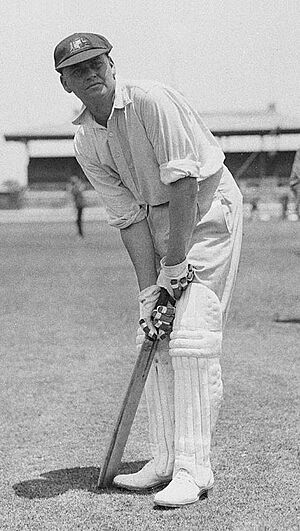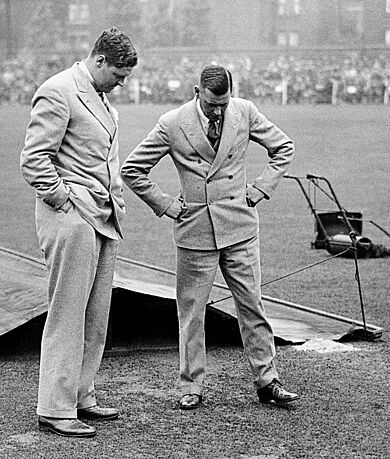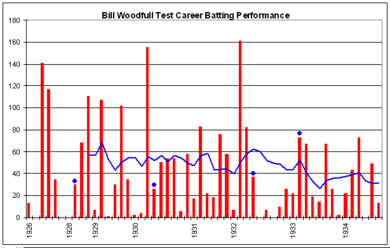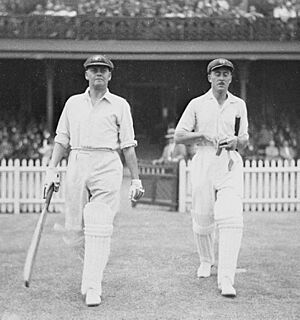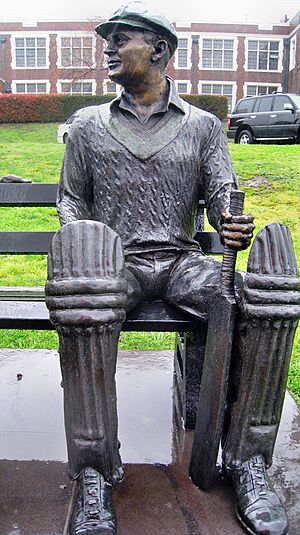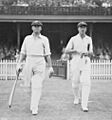Bill Woodfull facts for kids

Woodfull in 1934
|
||||||||||||||||||||||||||||||||||||||||
| Personal information | ||||||||||||||||||||||||||||||||||||||||
|---|---|---|---|---|---|---|---|---|---|---|---|---|---|---|---|---|---|---|---|---|---|---|---|---|---|---|---|---|---|---|---|---|---|---|---|---|---|---|---|---|
| Full name |
William Maldon Woodfull
|
|||||||||||||||||||||||||||||||||||||||
| Born | 22 August 1897 Maldon, Colony of Victoria |
|||||||||||||||||||||||||||||||||||||||
| Died | 11 August 1965 (aged 67) Tweed Heads, New South Wales, Australia |
|||||||||||||||||||||||||||||||||||||||
| Nickname |
|
|||||||||||||||||||||||||||||||||||||||
| Height | 1.80 m (5 ft 11 in) | |||||||||||||||||||||||||||||||||||||||
| Batting | Right-handed | |||||||||||||||||||||||||||||||||||||||
| Role | Opening batsman | |||||||||||||||||||||||||||||||||||||||
| International information | ||||||||||||||||||||||||||||||||||||||||
| National side | ||||||||||||||||||||||||||||||||||||||||
| Test debut (cap 123) | 12 June 1926 v England | |||||||||||||||||||||||||||||||||||||||
| Last Test | 22 August 1934 v England | |||||||||||||||||||||||||||||||||||||||
| Domestic team information | ||||||||||||||||||||||||||||||||||||||||
| Years | Team | |||||||||||||||||||||||||||||||||||||||
| 1922–1934 | Victoria | |||||||||||||||||||||||||||||||||||||||
| Career statistics | ||||||||||||||||||||||||||||||||||||||||
|
||||||||||||||||||||||||||||||||||||||||
|
Source: CricketArchive, 29 February 2008
|
||||||||||||||||||||||||||||||||||||||||
William Maldon Woodfull (22 August 1897 – 11 August 1965) was an Australian cricketer from the 1920s and 1930s. He was a captain for both Victoria and Australia. He was especially known for his calm and fair leadership during the difficult bodyline cricket series in 1932–33.
Woodfull was a schoolteacher. He was known for being kind to his players. As an opening batsman, he was patient and had a strong defensive style. He wasn't a flashy player, but he was very reliable, especially when things were tough. His partnership with fellow Victorian Bill Ponsford was one of the most successful in cricket history. Even though he wasn't known for his tactics, players and fans admired his sportsmanship. He built a strong and loyal team through his good character.
Woodfull started playing cricket young. He made his first professional appearance in Melbourne's local competition. At age 24, he played his first major match for Victoria in 1921–22. After scoring a century in his second game, he became an opening batsman. He stayed in that role for the rest of his career. In 1925–26, he scored three centuries, including a 236. This led to his selection for the 1926 tour of England. He was one of the last players chosen for the team. However, he scored a double century and a century in his first two games in England. This earned him a spot in the first Test match. Woodfull scored eight centuries during the tour. He also had the best batting average for Australia. He was named one of the five Wisden Cricketers of the Year.
After returning to Australia, Woodfull and Ponsford formed a strong partnership. In the 1926–27 season, they set a record with a 375-run opening stand. This helped Victoria achieve a world record team score of 1107 runs. Woodfull became vice-captain for the 1928–29 Ashes series. This happened after many older players retired. England won the series 4–1, but Woodfull scored three centuries. He also made his highest first-class score of 275 not out. In 1930, Woodfull reluctantly became captain. His team was very young, and some called it "Woodfull's kindergarten." After losing the first Test, Woodfull scored a century. Australia then won the series and regained the Ashes. He finished that tour with six first-class centuries. In 1931–32, Woodfull had his best Test series against South Africa. He scored 421 runs, including his highest Test score of 161.
Contents
What Was the Bodyline Series?
In 1932–33, the English team toured Australia. This series became very controversial. The English team used a tactic called bodyline. This meant they bowled the ball very fast at the Australian batsmen's upper bodies and heads. They hoped this would stop Australia's strong batting lineup. The Australian public and cricket fans hated this tactic. But Woodfull refused to fight back or complain publicly.
The controversy reached its peak during the third Test at the Adelaide Oval. Woodfull was hit hard in the chest by a ball. This almost caused a riot among the fans. After Woodfull was out, the English team manager, Plum Warner, came to express his sympathy. Woodfull famously replied, "I do not want to see you, Mr Warner. There are two teams out there. One is playing cricket and the other is not." England won the series 4–1. However, Woodfull was highly praised for his calm and strong behavior.
In 1934, Woodfull led the Australian team back to England. This tour was meant to improve relations after the Bodyline series. England promised not to use bodyline tactics again. Australia won the series 2–1. Woodfull is the only captain to win back the Ashes twice. He retired after this tour. His family believed the Bodyline controversy had made him lose his love for cricket. Woodfull, a mathematics teacher, later became the headmaster at his old school, Melbourne High School.
How Did Bill Woodfull Bat?
Woodfull's batting style wasn't very graceful. Wisden described him as looking "clumsy" at first. He had stiff joints from a childhood illness. He played with a small backlift, which made his style seem slow. Despite this, he scored many runs by placing the ball well. He also hit powerful drives using his strong forearms.
He was known for hitting the ball with a straight bat. He watched the ball very closely. These skills made him a strong defensive player. He was nicknamed "the unbowlable" because he was rarely bowled out. English bowlers also called him "wormkiller." This was because his backlift was so small, it seemed only enough to hit worms on the ground. He was also called "The Rock" and "Old Steadfast" because he was so reliable in tough games.
Woodfull and Bill Ponsford formed a famous opening partnership. They had 18 century stands together. Their teammates called them "Mutt and Jeff" or "Willy Wo and Willy Po." They are considered one of the best opening pairs in Test history. Their Victorian teammates trusted them so much that the wicket-keeper and lower-order batsmen would sometimes leave the field to go to work if Woodfull and Ponsford were batting.
What Kind of Captain Was He?
As a captain, Woodfull was known for his courage and strong moral values. This was especially true during the Bodyline series. Fellow player Stan McCabe called him "the greatest man I ever met." Wicket-keeper Bert Oldfield said Woodfull was an amazing person. Oldfield also said Woodfull was like a psychologist and a kind leader.
Don Bradman believed Woodfull's success came from his ability to earn his players' loyalty. This loyalty turned into great team spirit. Bill O'Reilly said Woodfull's players remembered his personal touch and courage forever. Cricket writer Jack Pollard said Woodfull was always there when things were tough. He brought great dignity to the Australian captaincy.
Woodfull was a true gentleman and always followed the spirit of the game. He refused to use unfair tactics, even against bodyline. Once, Jack Fingleton was run out by a teammate when he wasn't trying to score. The umpire said he was out, but Woodfull called Fingleton back to bat. He led his team quietly. He gave his players general goals and trusted them to achieve them. He also made sure his team was well-organized during tours.
Woodfull was a religious man, but he cared deeply about all his players. He would even help Catholic teammates find the nearest Catholic church. This was important because society at the time had divisions between different religious groups.
Early Life and Cricket Journey
William Woodfull was born in Maldon, a town in central Victoria. He was the third of four sons. His father, Reverend Thomas Woodfull, was a Methodist preacher. The family moved to Melbourne when his father was transferred. Woodfull kept his strong religious beliefs throughout his life. He once refused to play a match scheduled for Christmas Day. His father taught him cricket in their backyard, focusing on defense and patience. These became his key strengths.
Woodfull went to Melbourne High School. His early cricket career was not special. He started playing district cricket for Essendon at age 19 in 1916. He didn't play much more cricket until he became a schoolteacher in 1919. He was rejected from joining the army in World War I because of stiff muscles from rheumatic fever as a child. He was sent to Maryborough High School. There, he started to get noticed in local cricket. In 1920 and 1921, he scored 1,335 runs at an amazing average of 225.83.
In 1921, he moved back to Melbourne. Victorian selectors gave him a chance in trial matches. He scored 186 not out and 227 not out in two games. Victoria had so many good players that their second team was as strong as other states' main teams.
In early 1922, he made his first major debut in the Sheffield Shield. He scored 22 not out. In his second match, he scored his first century with 153 runs. He was not dismissed by a bowler in his first two matches. During this time, he also studied for an arts degree at night.
The next season, Woodfull became an opening batsman. He stayed in this role for his whole career. Between 1922 and 1926, he scored over 3,000 runs. He averaged 67 runs per game. In 1923–24, Victoria won the Sheffield Shield. Woodfull scored 300 runs, including 117 against New South Wales.
In 1924–25, he scored 81 and 120 not out against New South Wales. Victoria won that game. He scored 494 runs that season. After winning the Sheffield Shield, Victoria toured New Zealand. Woodfull scored 212 not out, 110, 50, and 150 not out against New Zealand. He was not dismissed at all in those games. He ended the tour with 706 runs. For two years, his defense was so good that he was never bowled out.
In 1925–26, players were trying to get selected for the 1926 Ashes tour. Woodfull scored 97 and 236 against South Australia. He also scored 126 in another match. These strong performances led to his selection for the Australian team. He scored 148 and 64 in matches before sailing to England. He finished the Australian season with 890 runs.
Test Match Debut
Even though he was one of the last players picked for the 1926 tour, Woodfull ended up with the best batting average in the main matches. He was also third in the Test matches.
In his first two games in England, Woodfull scored 201 against Essex and 118 against Surrey. Both scores were made on wet pitches. His 201 was the only double century by an Australian on that tour. These were the first of eight centuries he scored during the tour. He made 1809 runs in total.
Woodfull made his Test debut in the first Test at Trent Bridge. But the match was rained out, so Australia didn't get to bat. He didn't do well in the second Test at Lord's, scoring 13 and a duck. This was also a drawn match.
He then found his form again. He scored 102 not out against Nottinghamshire. In the third Test at Headingley, he scored his first Test century of 141. His opening partner was out on the first ball. But Woodfull and Charlie Macartney then made a huge partnership of 235 runs. Macartney attacked the bowlers, which helped Woodfull settle in. Australia scored 494 runs on a difficult pitch.
Woodfull scored another century in the fourth Test at Old Trafford with 117 runs. This was the highest score in that innings. This match was also a rain-affected draw.
The first four Tests were drawn, so the Ashes depended on the fifth Test. Woodfull scored 35 and a duck as Australia lost the Test and the Ashes. He scored 306 runs in the Tests, placing him third for Australia. He finished the tour with an unbeaten 116 against an England XI.
Back in Australia, he and Bill Ponsford set a record 375-run opening stand in 1926–27. This helped Victoria score a world record 1107 runs against New South Wales. Woodfull scored 133 in that game. He then toured Malaya and Singapore, scoring three centuries.
In 1927–28, Woodfull had a great season. He scored 99 and 191 not out against New South Wales. He also scored 106 against South Australia. He finished the season with 645 runs. With Ponsford also scoring many runs, Victoria easily won the Shield.
Woodfull scored his career-best of 284 runs during a tour to New Zealand. He also scored centuries in the first two matches. He finished the tour with 781 runs.
Becoming Captain
After Australia lost the previous Ashes series 4–1, captain Jack Ryder was not chosen for the 1930 Ashes tour. Woodfull was appointed captain. At first, Woodfull didn't want the job. He felt it belonged to Ryder. But when he learned Ryder wasn't even touring, he agreed after a vote. He was chosen by everyone on the board.
Woodfull led the youngest Australian team ever to tour England. Many people thought Australia would lose easily. Some even called the team "Woodfull's kindergarten."
The tour started well. Woodfull scored a century against Worcestershire. He also scored 121 against Yorkshire. He made 216 against Cambridge University. By the time the Tests started, Woodfull had scored 662 runs.
However, Woodfull's Test captaincy began with a loss. Australia lost the first Test by 93 runs. But he quickly bounced back. He scored 141 against Surrey.
In the second Test at Lord's, Woodfull and Ponsford had a 162-run opening stand. Woodfull then made a 231-run partnership with Don Bradman, scoring 155 runs himself. Australia won by seven wickets. Woodfull scored 50 in the third Test at Headingley, where Bradman scored 309 runs in one day. Australia scored 566, but rain saved England. The fourth Test was also rained out. With the series tied 1–1, the fifth Test at The Oval was a timeless match. Woodfull won the toss. After England scored 405, Australia scored 695. They won by an innings and regained the Ashes 2–1. Woodfull scored 345 runs in the Tests. The Times newspaper praised Woodfull's leadership.
Back in Australia, Woodfull was chosen for the national selection panel. But he resigned before the next international series.
Next, the West Indies toured Australia in 1930–31. Woodfull scored a duck against them in a state match. In the Tests, Woodfull moved down the batting order to No. 6. This was to make room for the talented young batsman Archie Jackson. Woodfull wasn't comfortable batting out of position. He scored six, 58, and 17 in the first three Tests. Australia won easily. Woodfull was moved back to opening for the fourth Test. He scored 83 runs. He then scored his first century of the season, making 177 runs in a state match. Australia won the series 4–1. Woodfull finished the summer with 477 runs.
The next season, the South Africans toured Australia. Woodfull started strongly, scoring 121 runs against them before the Tests. In the Tests, Woodfull scored 74 and 58 as Australia won the first two Tests. In the third Test, Woodfull scored 161 runs in the second innings. He and Bradman made a 274-run partnership. This helped Australia win by 169 runs. Woodfull finished the series with his best figures ever, 421 runs. Australia won all five Tests, a clean sweep. He ended the season with 849 runs.
Bodyline Series: A Tough Challenge
In 1932–33, the English team, led by Douglas Jardine, toured Australia. This was the famous Bodyline series. It is known as the most controversial period in Australian cricket history.
England's bodyline tactics involved bowling very fast balls at the Australian batsmen's heads and bodies. They also placed many fielders close to the leg side to catch deflections. England used these tactics to stop Donald Bradman, Australia's star batsman. But they also aimed to limit other batsmen, including Woodfull.
During this series, Woodfull's bravery and calm leadership earned him many fans. He refused to use the same aggressive tactics. He also did not complain publicly, even though he and his players were hit many times. Once the series was over, Woodfull refused to talk about it. He wanted to keep the peace.
Woodfull started the season well, scoring 74 and 83 in a match against New South Wales. But then he faced Jardine's Englishmen. He scored five and 25 as England easily beat Victoria. In the next match, England used full bodyline tactics. Woodfull struggled, scoring 18 and a duck.
Australia lost the first Test badly. Woodfull scored only seven and a duck. Before the second Test, there was talk that Woodfull might be removed as captain. This was because he refused to let his bowlers use similar tactics. His deputy, Victor Richardson, wanted to fight back. But Woodfull said, "There is no way I will be influenced to adopt such tactics which bring such discredit to the game."
Australia won the second Test, but Woodfull only scored 10 and 26. He was also hit by the bowling. The controversy reached its peak on the second day of the third Test. A huge crowd watched as Woodfull was hit in the chest by a fast ball from Harold Larwood. Woodfull bent over in pain. The crowd started booing and yelling at the English team. This was very unusual for the time. Jardine then moved his fielders into the bodyline positions. The crowd saw this as hitting a man when he was down. Many feared a riot.
Woodfull battled on for 89 minutes, getting more bruises. He was eventually bowled out for 22. Later that day, the English manager, Pelham Warner, visited the Australian dressing room to say he was sorry. Woodfull had stayed calm in public. But his private response to Warner became very famous:
I do not want to see you, Mr Warner. There are two teams out there. One is playing cricket and the other is not.
Woodfull reportedly added that the game was "too good to be spoilt." He hinted he might pull his team out in protest.
In the second innings, England set Australia an almost impossible target of 532 runs. Woodfull scored an unbeaten 73, carrying his bat as his teammates struggled. Australia was all out for 193.
Woodfull scored 67, 19, 14, and 67 in the final two Tests, which Australia lost. In the fifth Test, Larwood broke a bone in his foot. But Jardine made him finish the over. Woodfull refused to take advantage of the injured bowler. He blocked the remaining balls back to Larwood and didn't try to score.
England won the Ashes 4–1. Woodfull scored 305 runs at an average of 33.89. This was his slowest scoring rate. But he stayed at the crease for over twenty hours, more than any other Australian.
In 1933–34, cricket returned to normal. Woodfull scored 118 in a match between his team and Richardson's team. He also scored 129 in a chase against New South Wales. He scored centuries before his final tour of England. He ended the season with 818 runs, getting back to his best form.
Final International Tour
In 1934, Woodfull led Australia back to England. This tour was important to fix relations after the Bodyline series. Agreements were made that bodyline tactics would not be used. However, sometimes the Australians felt the English bowlers went too far.
Woodfull started his final English tour slowly. He offered to drop himself from the team because of his poor form. But fellow selectors Bradman and Alan Kippax disagreed. He then found his form, scoring 172 not out against Lancashire.
In the first Test, Woodfull scored 26 and two. Australia won by 238 runs. England fought back in the second Test. Woodfull made 22 as Australia lost by an innings. He then scored 73 in the third Test, which was a draw. Woodfull scored a duck in the fourth Test. But another triple century from Bradman helped Australia control the game. The series was tied 1–1 going into the final Test.
Before the decider, Woodfull scored 131 and 228 not out in two matches. However, there was controversy in a match against Nottinghamshire. Bill Voce, one of the bodyline bowlers from 1932–33, used similar tactics. He bowled very fast balls at Woodfull's head.
Woodfull told the Nottinghamshire officials that if Voce continued, his team would leave the field. The next day, Voce was absent. The Nottinghamshire fans booed the Australians all day.
In the deciding Test, Woodfull won the toss and chose to bat. He scored 49 as Australia made 701 runs. England replied with 321. Woodfull scored 13 in his final Test innings. Australia then set England a target of 708 runs. His bowlers dismissed England for 145 runs. Australia won by 562 runs and took the series 2–1. On 22 August, Australia won the Ashes on Woodfull's birthday for the second time.
This victory made Woodfull the only captain to regain the Ashes twice. He scored 1,268 runs during the tour. He captained 25 Tests, which was a world record for a long time.
Woodfull didn't score many runs in the Tests, but Australia won because Bradman and Ponsford scored a lot. Also, Clarrie Grimmett and Bill O'Reilly took many wickets. Woodfull was sometimes criticized for being too defensive as a captain. He preferred to bat opponents out of the game rather than going for a quick win. He relied on O'Reilly and Grimmett for bowling. He was very good at limiting top English batsmen like Wally Hammond. Hammond averaged half as much when Woodfull was captain compared to other Australian captains.
Woodfull retired right after the tour. He was given a special match with Ponsford when he returned to Victoria. This match raised a lot of money. In this game, Woodfull scored 111 in his final innings. He also took his only first-class wicket.
Life After Cricket
After cricket, Woodfull became a successful mathematics teacher. He was headmaster at Box Hill High School and later at Melbourne High School for six years. He was known for being strict. One of his students was future Australian Test player Keith Miller. Miller was not a good student and focused on sports. This disappointed Woodfull, who believed in hard work. Miller failed Woodfull's geometry class and had to repeat the year.
Even though he was a great cricketer, Woodfull refused to coach the school's cricket teams. He felt it was the sports teachers' job. But he watched the students train and quickly noticed Miller's talent. He wrote in the school magazine that "Miller has Test possibilities." Other famous students included Doug Ring and Ron Clarke. The school oval was later named the Miller-Woodfull Oval.
The oval in his hometown of Maldon was renamed the Bill Woodfull Recreation Reserve. When the Great Southern Stand was built at the Melbourne Cricket Ground in 1992, one of the entrances was named the Bill Woodfull Gate.
Woodfull married Gwen King, whom he met singing in his father's church choir. They had three children. His two sons became successful dentists.
In 1934, the Governor-General told him that the King wanted to give him a knighthood for his services to cricket. This was a way of recognizing his actions during the Bodyline series. But Woodfull believed his work in education was more important than cricket. He refused the knighthood. He later said, "Had I been awarded it for being an educationalist, then I would have accepted it. But under no circumstances would I accept it for playing cricket." In 1963, he was given the Order of the British Empire (OBE) for his work in education.
In 1965, Woodfull died while playing golf in Tweed Heads, New South Wales. His family believed the Bodyline series had permanently affected his health. In 2001, Woodfull was inducted into the Australian Cricket Hall of Fame.
Test match performance
| Batting | Bowling | ||||||||
|---|---|---|---|---|---|---|---|---|---|
| Opposition | Matches | Runs | Average | High Score | 100 / 50 | Runs | Wickets | Average | Best (Inns) |
| 25 | 1675 | 44.07 | 155 | 6/8 | – | – | – | – | |
| 5 | 421 | 70.16 | 161 | 1/3 | – | – | – | – | |
| 5 | 204 | 34.00 | 83 | 0/2 | – | – | – | – | |
| Overall | 35 | 2300 | 46.00 | 161 | 7/13 | – | – | – | – |
Images for kids


